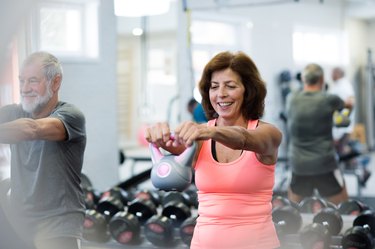
Trying to shed pounds but don't know which type of exercise is most effective? Well, when it comes to weight loss, nothing beats weight training.
That's because, unlike aerobic exercise, which may lessen your muscle mass, pumping iron increases your lean muscle. And, since muscle scorches more calories than fat — even when you're at rest — lifting weights will transform your body into a calorie-torching machine.
Video of the Day
Video of the Day
Read more: How to Lose Weight Fast — the Healthy Way
What's more, weight training can keep you strong in your golden years as your muscle mass begins to dwindle. In fact, resistance exercise can even protect you from bone loss and fractures, which become more prevalent when you're trying to drop pounds at an older age, according to a December 2019 study published in the Journal of Bone and Mineral Research. Researchers found that strength training, alone or combined with aerobic exercise, helped older adults preserve bone density while they pursued their weight-loss goals.
So, how often should you incorporate weight training into your fitness routine? According to the Department of Health and Human Services' Physical Activity Guidelines for Americans, adults should aim for at least two days a week of moderately (or more) intense muscle-strengthening activities.
A 20-Minute Bone-Strengthening Workout
This fully-body strength routine, designed by Geoff Tripp, CSCS, certified personal trainer and head of fitness at Trainiac, will blast calories and protect your bones at the same time. The best part? It only takes 20 minutes out of your day.
For this workout, Tripp suggests following this format:
- Start with three to five minutes of dynamic stretching to warm up your muscles
- Perform each move for 10 to 12 reps
- Rest for 30 seconds between each move
- Repeat the circuit two times total, resting for 1 minute in between rounds
- Cool down with a series of static stretches
1. Barbell Push-Up
- Secure a barbell at hip height in a squat rack.
- Place your hands on the bar, just beyond shoulder-width apart.
- Your body should form a straight line from your head to your heels.
- Keep your core and glutes tight as you lower your body until your chest almost touches the bar.
- Engaging your chest muscles, push your body up back to starting position.
2. TRX Pull-Ups
- Gripping the suspension straps, start in an extended position (facing the ceiling) with your back straight, hips tucked and feet shoulder-width apart.
- Squeeze your shoulder blades, bend your elbows and keep your wrists straight as you pull your body up until your hands are at the side of your chest.
- Slowly lower your body back down to the starting position.
Tip
Don't have suspension straps on hand? You can use a barbell or Smith machine bar to perform this move, too.
3. Kettlebell Goblet Squat to Bench
- Stand next to a bench and grip a kettlebell at chest height.
- Push your hips back and down as you bend your knees and lower into a sitting squat (making sure your knees don't go over your toes).
- Then, drive through your quads and glutes to stand.
Read more: The 12 Best Kettlebell Exercises You're Not Doing
4. Seated Leg Curl
- Select a moderately heavy weight.
- Take a seat on the leg curl machine with your back placed comfortably against the pad and the padded bar placed just below your knees.
- Flex your legs, using your quadriceps, until they are fully extended.
- Squeeze and hold for a brief second before slowly releasing back to the starting position.
5. Cable Band Press
- Adjust the cable machine so that it's about chest height.
- Grab the handle with both hands and take two or three steps out so that there's tension on the cable.
- Keep your core engaged as you press the cable straight out in front of your body, being sure not to rotate your body.
- Return to starting position. Repeat for 10 to 12 reps, then switch sides.
6. Rope Curls
- Secure a rope attachment to a low pulley and stand facing the cable machine.
- Grab the rope with a neutral grip (palms inward) and take a step back.
- Keep your elbows in by your side as you pull the rope up.
- Squeeze your biceps at the top of the movement, then lower back to starting position.
7. Rope Tricep Extensions
- Secure a rope attachment to a high pulley and stand facing the cable machine.
- Grab the rope with both hands (palms downward) and take a step back.
- Keep your elbows at your side as you pull the rope down.
- Squeeze your triceps at the bottom of the movement, then slowly return to starting position.
8. Cable Chest Press
- Using a cable machine, position the pulleys to chest height and select a moderately heavy weight.
- Grab the handles with an overhand grip and step forward.
- Press the weight away from your body until your arms are straight.
- Slowly bring your arms back to your chest.
9. Cable Squat to Row
- Using a cable machine, position the pulleys to chest height.
- Grab a handle in each hand and stand facing the cable machine with feet hip-width apart.
- Bend your knees and sit back, lowering your body into a squat.
- As you stand, bend your elbows and pull the handles to the sides of your chest, squeezing your back muscles.
Check out more of our 20-minute workouts here — we’ve got something for everyone.